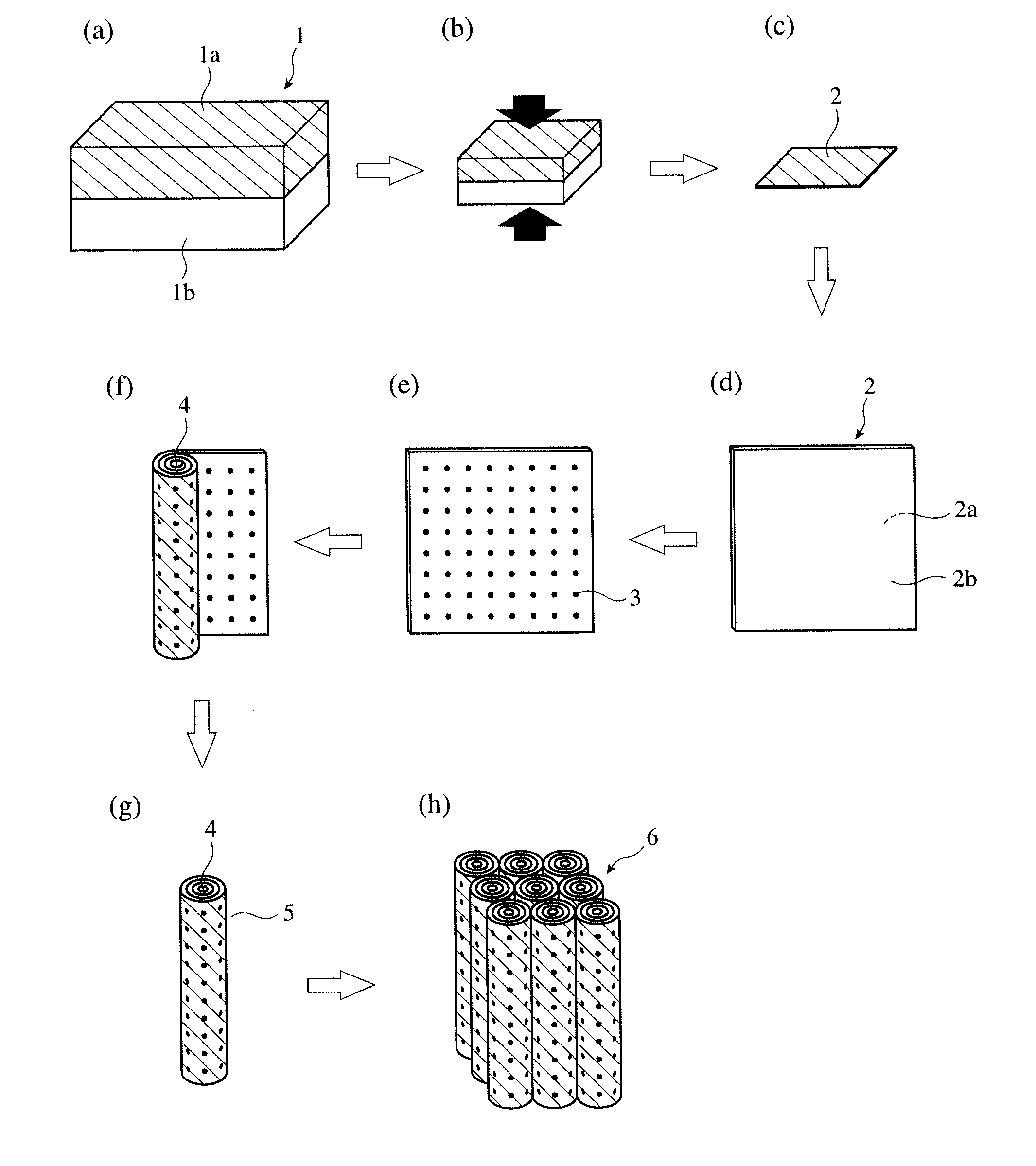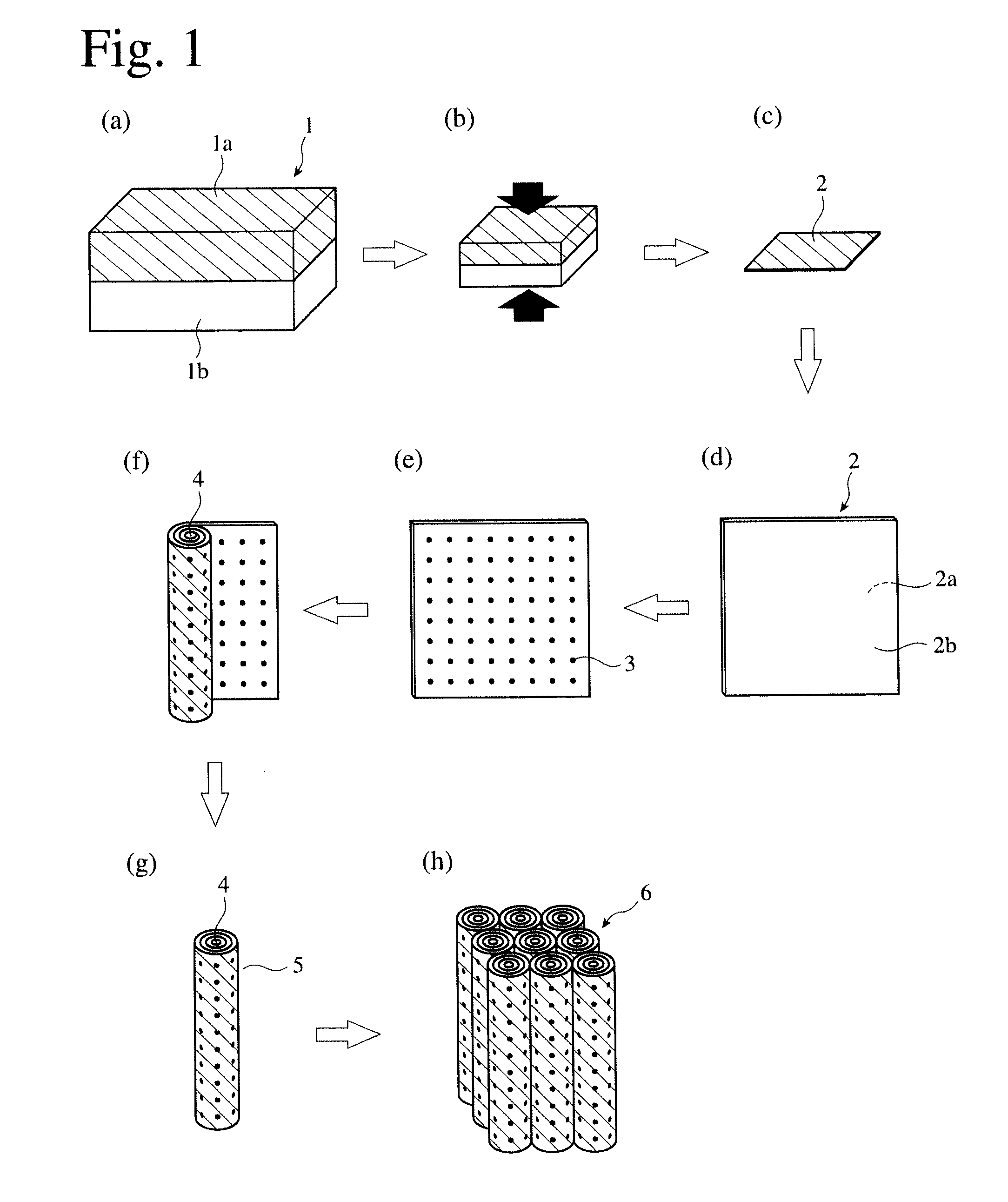Artificial bone capable of being absorbed and replaced by autogenous bone and its production method
a technology of autogenous bone and artificial bone, which is applied in the field of artificial bone, can solve the problems of disadvantageous low strength, inability to use alone in a body part subject to stress, and difficulty in handling artificial bones of ceramics typified by hydroxyapatite during operation, and achieve excellent tissue penetration and bone conduction
- Summary
- Abstract
- Description
- Claims
- Application Information
AI Technical Summary
Benefits of technology
Problems solved by technology
Method used
Image
Examples
example 1
(A) Synthesis of Apatite / Collagen Composite Fibers
[0059]235 g of an aqueous solution of collagen in phosphoric acid (collagen concentration: 0.85% by mass, and phosphoric acid concentration: 20 mM) was added to 168 ml of a 120-mM aqueous phosphoric acid solution and stirred, to prepare a diluted aqueous solution of collagen in phosphoric acid. Further, 200 ml of a 400-mM calcium hydroxide suspension was prepared. 200 ml of pure water was introduced into a reaction vessel and heated to 40° C. The diluted aqueous solution of collagen in phosphoric acid and the calcium hydroxide suspension were simultaneously dropped into this reaction vessel both at a speed of about 30 ml / minute, and the resultant reaction solution was stirred at 200 rpm to prepare slurry containing apatite / collagen composite fibers. The reaction solution was kept at pH of 8.9-9.1 during dropping. The resultant apatite / collagen composite fibers were substantially as long as 1 mm or less. The slurry containing apatite / ...
examples 2-5
[0066]Artificial bones each constituted by a cylindrical body of an apatite / collagen composite sheet and a collagen sheet, which had a hollow center portion having the diameter shown in Table 1, were produced in the same manner as in Example 1 except for changing the thickness of a core rod, around which the apatite / collagen composite sheet and the collagen sheet were rolled.
TABLE 1Diameter of HollowNo.Center Portion (μm)Example 1500Example 2100Example 3200Example 4700Example 51000
example 6
[0067]An apatite / collagen composite gel produced in the same manner as in Example 1 was put in a mold, and a 0.5-%-by-mass aqueous collagen solution was poured onto the gel. They were kept at 37° C. for 2 hours to cause gelation, thereby obtaining a jelly-like molding. This molding was frozen at −20° C., and then dried by a freeze drier to obtain a two-layer, integral, porous block of 10 mm×10 mm×4 mm comprising a 2-mm-thick apatite / collagen composite sheet and a 2-mm-thick collagen sheet bonded to each other.
[0068]This two-layer, integral, porous block was compressed under pressure of 100 kg / cm2 by a monoaxial press at room temperature for 60 seconds, to a two-layer, sheet of 10 mm×10 mm×0.3 mm comprising a 0.15-mm-thick apatite / collagen composite layer and a 0.15-mm-thick collagen layer. This two-layer, sheet was rolled around a rod core of 500 μm in diameter made of Teflon (registered trademark) with the collagen layer outside, to obtain a cylindrical body of 10 mm in length, 1.1...
PUM
| Property | Measurement | Unit |
|---|---|---|
| diameter | aaaaa | aaaaa |
| diameters | aaaaa | aaaaa |
| pH | aaaaa | aaaaa |
Abstract
Description
Claims
Application Information
 Login to View More
Login to View More - R&D
- Intellectual Property
- Life Sciences
- Materials
- Tech Scout
- Unparalleled Data Quality
- Higher Quality Content
- 60% Fewer Hallucinations
Browse by: Latest US Patents, China's latest patents, Technical Efficacy Thesaurus, Application Domain, Technology Topic, Popular Technical Reports.
© 2025 PatSnap. All rights reserved.Legal|Privacy policy|Modern Slavery Act Transparency Statement|Sitemap|About US| Contact US: help@patsnap.com


